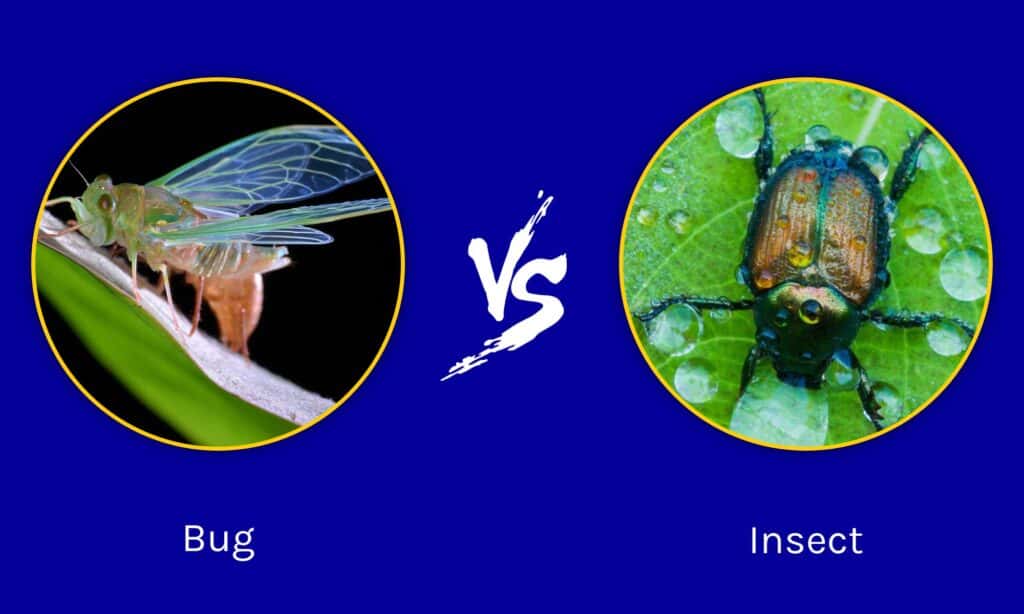The vast majority of people use the words bug and insect interchangeably. Did you know that those terms actually refer to specific groups of creatures? More importantly, are you ready to learn the differences between bugs vs insects? Whether you are a pedant or just trying to learn something new, we have you covered.
We’re going to break down the three most significant differences between insects and bugs. We’ll clear up any questions you have about these invertebrates.
Comparing Bugs and Insects

Image needed: bugs vs insects
| Bugs | Insects | |
|---|---|---|
| Scientific Classification | – Insecta class – Hemiptera order | – Insecta class |
| Metamorphosis | – No larval metamorphosis – Referred to as an incomplete or gradual metamorphosis – 3 Stages of life – Hatch from eggs to become nymphs and then molt to become adults | – May undergo full metamorphosis or incomplete metamorphosis – Most undergo metamorphosis in a four-stage lifecycle of egg, larva, pupa, adults – Incomplete metamorphosis requires molting to take place for growth |
| Morphology | – Have specialized mouthparts called a proboscis that allow them to suck fluids – This straw-like structure that helps them drink is not retractable – Four wings, an outer and inner pair – Outer or front pair of wings are leathery at the base and membranous at the end – Under or rear pair of wings are membranous – Compound eyes – Exoskeleton | – Possess three pairs of jointed legs – Two antennae – Chitinous exoskeleton – Two pairs of wings when present – Compound eyes |
| Examples | – Cicadas, aphids, stink bugs, bed bugs, wheel bugs, assassin bug | – Bees, flies, beetles, dragonflies, |
The 3 Key Differences Between Bugs vs Insects

The stink bug has a non-retractable proboscis like other true bugs
©Jay Ondreicka/Shutterstock.com
The biggest differences between bugs and insects are their morphology and scientific classification. Insects are from the Insecta class and are known for having two antennae, a chitinous exoskeleton, compound eyes, three jointed pairs of legs, and a segmented body, but bugs are from the Insecta class and Hemiptera order and they have many structures like insects except they have unique outer and inner wings along with non-retractable specialized mouthparts called a proboscis that helps them drink fluids.
These are the primary differences between bugs and insects, but they are not the only ones, and we have not gone into sufficient depth to differentiate the creatures just yet. With that in mind, we’re going to delve further into these unique qualities that separate bugs and insects. By the time we’re finished here, you’ll know how to tell them apart.
Bugs vs Insects: Scientific Classification
All insects belong to the Insecta class, and bugs belong to the order Hemiptera within that class. All bugs are insects, but not all insects are bugs. Is that confusing? Let’s clarify that introduction by taking a look at the scientific classification of bugs and insects.
Generally speaking, all insects are members of the Insecta class of animals. From there, they split off into various superorders and orders. All of the creatures that are within those superorders and orders are insects, but they’re not all bugs.
When we talk about true bugs, we are only referencing a single order within that phylogenetic tree. This order is called the Hemiptera, roughly translating to “half wing”. Every one of the 80,000 or more bugs that are within that order is an insect. In that sense, every bug is an insect but not every insect is a bug because there are many other orders within the Insecta class.
However, some entomologists only consider the Heteroptera group within the order to be true bugs.
Bugs vs Insects: Metamorphosis

Some insects undergo complete metamorphosis, but no bugs do
©Bryan Nature Photography/Shutterstock.com
The presence of a complete metamorphosis or a gradual metamorphosis is another method that scientists use to differentiate bugs from insects. Generally speaking, insects either undergo a complete metamorphosis or undergo an incomplete metamorphosis. However, bugs only experience an incomplete metamorphosis.
If you recall from your science classes, some insects undergo a four-stage lifecycle that includes a complete metamorphosis. This starts with an egg that hatches and develops into a larva. For example, a caterpillar is the larval stage of a butterfly or moth. After the larva has matured to an extent, it enters a pupa phase.
A caterpillar will spin a silk cocoon. Within that cocoon, the insect undergoes a massive physical alteration that is called metamorphosis. Caterpillars break down into what has been colorfully described as “caterpillar soup.” The insect then reconfigures in its adult form, a butterfly or a moth, and emerges from the chrysalis.
In the case of bugs and some other insects, they are born from eggs into their nymph form. They change slowly by molting their exoskeleton and growing into their adult forms. Their changes are not as drastic, and they take much longer. This three-stage life cycle is found in bugs, and it’s an example of an incomplete or gradual metamorphosis.
Bugs vs Insects: Morphology

Butterflies are an example of an insect that is not a bug due to their wings and metamorphosis
©iStock.com/Elenathewise
Bugs and insects also have a unique morphology. For the most part, insects have three jointed pairs of legs, one pair on each section of their body with three segments. Also, they have two antennae, a chitinous exoskeleton, two pairs of wings when present, and compound eyes. Most of these characteristics are found in bugs. Of course, there are a few exceptions.
The biggest exception is that bugs have specialized mouthparts called a proboscis. This is a non-retractable, penetrating straw-like structure that allows them to drink fluids. For example, a bed bug uses its proboscis to drink blood. Some insects can retract their proboscis
Another significant difference is the composition of bugs’ wings. They have two pairs, front wings as well back wings. The outer pair has a leathery base and a very membranous tip. These wings are usually folded over the back in an X shape when they are at rest.
Other insects have a variety of wing structures and shapes rather than the half wing for which the Hemiptera order gets its name. Other than that, true bugs are very similar to insects. They have compound eyes, exoskeletons, and segmented thoraxes.
Bugs have many commonalities with insects, but they also differ in some rather large ways. With the information we’ve presented here, you now have a good idea of the important differences between these two groups of creatures.
The photo featured at the top of this post is © kesipun/Shutterstock.com
Thank you for reading! Have some feedback for us? Contact the AZ Animals editorial team.







